Mathias hedding med surg SIM 42 PDF

| Title | Mathias hedding med surg SIM 42 |
|---|---|
| Course | Med Surg |
| Institution | Fortis College |
| Pages | 2 |
| File Size | 52.3 KB |
| File Type | |
| Total Downloads | 99 |
| Total Views | 133 |
Summary
simulation...
Description
SIM: 42- Mathias Hedding- Wound Infection/Fluid Overload and Hyperglycemia 1. What is the pathophysiology of heart failure? Heart failure is a complex clinical syndrome that develops in response to myocardial injury in results in decreased heart function. Its onset are the result of neurohormonal compensatory mechanisms activated in response to myocardial dysfunction. It leads to remodeling of myocardial structure and function. Heart failure can be caused by cardiomyopathy, congenital heart defects, CAD (including MI), HTN (including hypertensive crisis), hyperthyroidism, myocarditis, pulmonary HTN, rheumatic heart disease, and valvular disorders. Left sided heart failure is the most common form of HF and is caused by impaired contractile function, increased afterload, cardiomyopathy, and mechanical abnormalities. The heart muscles become weakened and cannot generate effective SV, which will impair CO. Left-sided HF results from the inability of the left ventricle to empty effectively during systole or effectively during diastole. Right sided heart failure is when the right ventricle does not pump adequately and the right ventricle fails, which causes fluid to back up into the venous system. Right sided heart failure is most commonly caused by left sided heart failure because when the left side fails fluid backs up into the pulmonary system. Right sided heart failure causes movement of fluid into the tissues and organs such as peripheral edema, jugular venous distention (JVD), abdominal ascites, and hepatomegaly. Therefore, this makes the right ventricle work harder to push blood to the pulmonary system and it causes an increase in workload, which weakens the right ventricle then it slowly starts to fail. 2. What are the signs and symptoms of heart failure? The signs of right sided heart failure are right ventricular heaves, increased heart rate, murmurs, jugular venous distention, edema, weight gain, ascites, anasarca, and hepatomegaly. The symptoms of right sided heart failure are fatigue, anxiety, depression, right upper quadrant pain, anorexia, GI bloating, and nausea. Signs of left sided heart failure are left ventricular heaves, increased heart rate, pulsus alternans, PMI displaced inferiorly and left of the midclavicular line, decreased PaO2, slight increase in PaCO2, crackles, S3 and S4 heart sounds, pleural effusion, change in mental status, restlessness, confusion, shallow respirations up to 32-40/min, dry and hacking cough, and frothy and pinktinged sputum. Symptoms of left sided heart failure are weakness, fatigue, anxiety, depression, dyspnea, paroxysmal nocturnal, orthopnea, and nocturia. 3. When a patient exhibits heart failure, the body attempts to compensate for the decreased cardiac output. What signs and symptoms will a patient exhibit that reflects these compensatory mechanisms? Why are these dangerous? The compensatory mechanisms are neurohormonal responses: renin-angiotensin-aldosterone system (RAAS) and the sympathetic nervous system (SNS); and ventricular dilation, and ventricular hypertrophy. RAAS and SNS in HF leads to an increased level in ADH which causes vasoconstriction, increased BP, and increased central venous pressure. With chronic RAAS, it can cause dangerous effects such as cardiac myocyte apoptosis (programmed cell death), hypertrophy, and fibrosis. In the SNS with HF, the baroreceptors sense low arterial pressure which stimulates the SNS to maintain CO. Then, catecholamines are released which causes an increase in heart rate (chronotropy) and increase in ventricular contractility (inotropy). Chronic SNS stimulation causes myocardial oxygen demand and weakens the heart. With continuous compensatory mechanisms of the RAAS and SNS it causes the heart to have an increase in workload and intensify ventricular dysfunction which leads to ventricular remodeling. Ventricular dilation is caused by elevated pressure in the heart
chambers over time. It enlarges the heart chambers, and the heart muscle fibers stretch because of the volume of blood in the heart at the end of diastole. Then that causes a further increase in preload. Ventricular hypertrophy is the adaptive increase in muscle mass and heart wall thickness. It is a slow response to the heart straining and over working. Over time, as the heart becomes thicker and increases more and more in muscle mass the heart will have poor contractility, it will need more oxygen to perform, will have poor coronary artery circulation, and becomes more prone to dysrhythmias. 4. Which lab value supports the diagnosis of heart failure? BNP and N-terminal prohormone of BNP (NT-proBNP) levels correlate positively with the degree of LV failure. 5. Describe the different manifestations associated with left and right-sided heart failure. Manifestations of right-sided heart failure are right ventricular heaves, increased heart rate, murmurs, jugular venous distention, edema, weight gain, ascites, anasarca, hepatomegaly, fatigue, anxiety, depression, right upper quadrant pain, anorexia, GI bloating, and nausea. Manifestations of left-sided heart failure are left ventricular heaves, increased heart rate, pulses alternans, PMI displaced inferiorly and left of the midclavicular line, decreased PaO2, slightly increased PaCO2, crackles (pulmonary edema), S3 and S4 heart sounds, pleural effusion, change in mental status, restlessness, confusion, shallow respirations up to 32-40/min., dry, hacking cough, frothy pink-tinged sputum, weakness, fatigue, anxiety, depression, dyspnea, paroxysmal nocturnal dyspnea, orthopnea, and nocturia. 6. What effect does the blood glucose levels have on wound healing? When blood glucose levels are elevated, it can stiffen blood vessels and that causes them to become narrower. Therefore, that makes it difficult for blood to flow or decreased blood flow. With decreased blood flow, oxygen, WBCs, and vital nutrients are not available for the tissues. So, it will take the wound longer to heal and have a higher risk for infection....
Similar Free PDFs

Mathias hedding med surg SIM 42
- 2 Pages
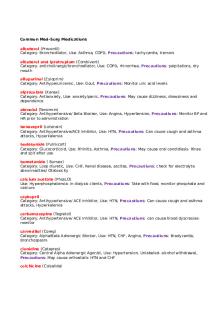
Common Med Surg Meds
- 7 Pages

Med surg dorris bowman
- 4 Pages
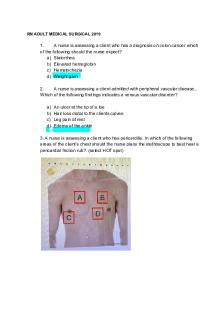
Med surg - notes
- 28 Pages
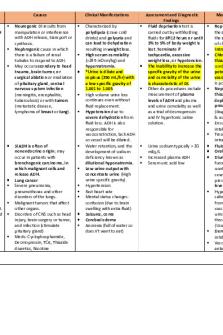
Med-Surg Endocrine
- 11 Pages
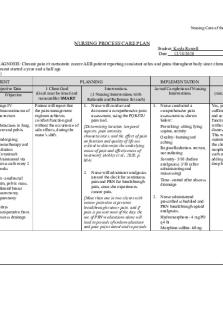
Med Surg- Care Plan
- 6 Pages
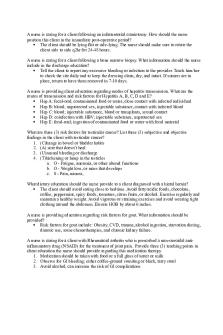
Med-Surg Capstone remediation
- 4 Pages

Med Surg Exam 3
- 19 Pages
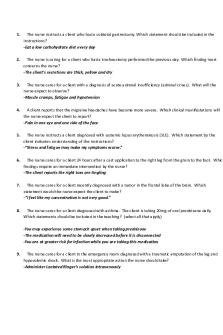
Kaplan med surg 2
- 8 Pages

Med surg 1
- 33 Pages

med surg review questions
- 7 Pages

Adv med surg remediation
- 2 Pages
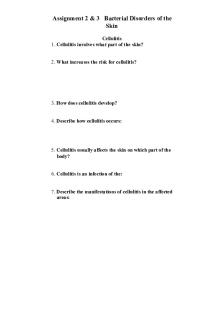
Med SURG; assignment 2
- 9 Pages

Med Surg ATI Remediation
- 6 Pages
Popular Institutions
- Tinajero National High School - Annex
- Politeknik Caltex Riau
- Yokohama City University
- SGT University
- University of Al-Qadisiyah
- Divine Word College of Vigan
- Techniek College Rotterdam
- Universidade de Santiago
- Universiti Teknologi MARA Cawangan Johor Kampus Pasir Gudang
- Poltekkes Kemenkes Yogyakarta
- Baguio City National High School
- Colegio san marcos
- preparatoria uno
- Centro de Bachillerato Tecnológico Industrial y de Servicios No. 107
- Dalian Maritime University
- Quang Trung Secondary School
- Colegio Tecnológico en Informática
- Corporación Regional de Educación Superior
- Grupo CEDVA
- Dar Al Uloom University
- Centro de Estudios Preuniversitarios de la Universidad Nacional de Ingeniería
- 上智大学
- Aakash International School, Nuna Majara
- San Felipe Neri Catholic School
- Kang Chiao International School - New Taipei City
- Misamis Occidental National High School
- Institución Educativa Escuela Normal Juan Ladrilleros
- Kolehiyo ng Pantukan
- Batanes State College
- Instituto Continental
- Sekolah Menengah Kejuruan Kesehatan Kaltara (Tarakan)
- Colegio de La Inmaculada Concepcion - Cebu

